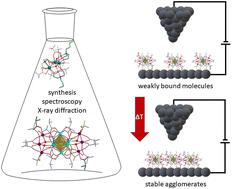当前位置:
X-MOL 学术
›
Dalton Trans.
›
论文详情
Our official English website, www.x-mol.net, welcomes your feedback! (Note: you will need to create a separate account there.)
Synthesis and structures of cobalt-expanded zirconium- and cerium-oxo clusters as precursors for mixed-metal oxide thin films
Dalton Transactions ( IF 4 ) Pub Date : 2024-04-25 , DOI: 10.1039/d4dt00328d Maximilian Seiß 1, 2 , Jonas Lorenz 1 , Sebastian Schmitz 1 , Marco Moors 1 , Martin Börner 2 , Kirill Yu. Monakhov 1
Dalton Transactions ( IF 4 ) Pub Date : 2024-04-25 , DOI: 10.1039/d4dt00328d Maximilian Seiß 1, 2 , Jonas Lorenz 1 , Sebastian Schmitz 1 , Marco Moors 1 , Martin Börner 2 , Kirill Yu. Monakhov 1
Affiliation

|
Transforming current complementary metal–oxide–semiconductor (CMOS) technology to fabricate memory chips and microprocessors into environmentally friendlier electronics requires the development of new approaches to resource- and energy-efficient electron transport and switching materials. Metal and multi-metal oxide layers play a key role in high-end technical applications. However, these layers are commonly produced through high-energy and high-temperature procedures. Herein, we demonstrate our first attempts to obtain stimuli-responsive mixed-metal oxide thin films from solution-processed molecular precursors under milder conditions. The molecular compounds of interest were prepared by one-pot reactions of a CoII carboxylate complex, triethylamine (Et3N), N-butyldiethanolamine (H2bda), and a hexanuclear complex [Ce6O4(OH)4(piv)12] (Hpiv = pivalic acid) or [Zr6O4(OH)4(ib)12(H2O)]·3Hib (Hib = isobutyric acid) in acetonitrile solution. The resulting charge-neutral, heterometallic coordination compounds display a ligand-supported pentanuclear {CeIV3CoIII2} core (in 1) and a dodecanuclear {ZrIV6CoII6} core (in 2), exhibiting thermal stability up to ca. 100 °C in air. Compound 2 was deposited and analyzed on Au(111) and SiO2/Si(100) surfaces to explore its potential as a single-molecule precursor for the preparation of atomically precise, complex mixed-metal oxide thin films. The adsorption characteristics of it demonstrate the ability to form stable agglomerates on the investigated surfaces.
中文翻译:

作为混合金属氧化物薄膜前体的钴膨胀锆和铈氧簇的合成和结构
将当前的互补金属氧化物半导体 (CMOS) 技术转变为更环保的电子产品,需要开发资源和能源高效的电子传输和开关材料的新方法,以制造存储芯片和微处理器。金属和多金属氧化物层在高端技术应用中发挥着关键作用。然而,这些层通常是通过高能和高温过程产生的。在这里,我们展示了我们在温和条件下从溶液处理的分子前体获得刺激响应混合金属氧化物薄膜的首次尝试。感兴趣的分子化合物是通过 Co II羧酸盐络合物、三乙胺 (Et 3 N)、N-丁基二乙醇胺 (H 2 bda) 和六核络合物 [Ce 6 O 4 (OH) 4 (piv ) 的一锅反应制备的。 ) 12 ] (Hpiv = 新戊酸) 或 [Zr 6 O 4 (OH) 4 (ib) 12 (H 2 O)]·3Hib (Hib = 异丁酸) 乙腈溶液。所得电荷中性的异金属配位化合物显示出配体支持的五核 {Ce IV 3 Co III 2 } 核(在1中)和十二核 {Zr IV 6 Co II 6 } 核(在2中),表现出热稳定性高达约空气中100°C。在 Au(111) 和 SiO 2 /Si(100) 表面上沉积并分析化合物2,以探索其作为单分子前驱体用于制备原子级精确的复杂混合金属氧化物薄膜的潜力。其吸附特性表明其能够在所研究的表面上形成稳定的团聚物。
更新日期:2024-04-30
中文翻译:

作为混合金属氧化物薄膜前体的钴膨胀锆和铈氧簇的合成和结构
将当前的互补金属氧化物半导体 (CMOS) 技术转变为更环保的电子产品,需要开发资源和能源高效的电子传输和开关材料的新方法,以制造存储芯片和微处理器。金属和多金属氧化物层在高端技术应用中发挥着关键作用。然而,这些层通常是通过高能和高温过程产生的。在这里,我们展示了我们在温和条件下从溶液处理的分子前体获得刺激响应混合金属氧化物薄膜的首次尝试。感兴趣的分子化合物是通过 Co II羧酸盐络合物、三乙胺 (Et 3 N)、N-丁基二乙醇胺 (H 2 bda) 和六核络合物 [Ce 6 O 4 (OH) 4 (piv ) 的一锅反应制备的。 ) 12 ] (Hpiv = 新戊酸) 或 [Zr 6 O 4 (OH) 4 (ib) 12 (H 2 O)]·3Hib (Hib = 异丁酸) 乙腈溶液。所得电荷中性的异金属配位化合物显示出配体支持的五核 {Ce IV 3 Co III 2 } 核(在1中)和十二核 {Zr IV 6 Co II 6 } 核(在2中),表现出热稳定性高达约空气中100°C。在 Au(111) 和 SiO 2 /Si(100) 表面上沉积并分析化合物2,以探索其作为单分子前驱体用于制备原子级精确的复杂混合金属氧化物薄膜的潜力。其吸附特性表明其能够在所研究的表面上形成稳定的团聚物。



























 京公网安备 11010802027423号
京公网安备 11010802027423号